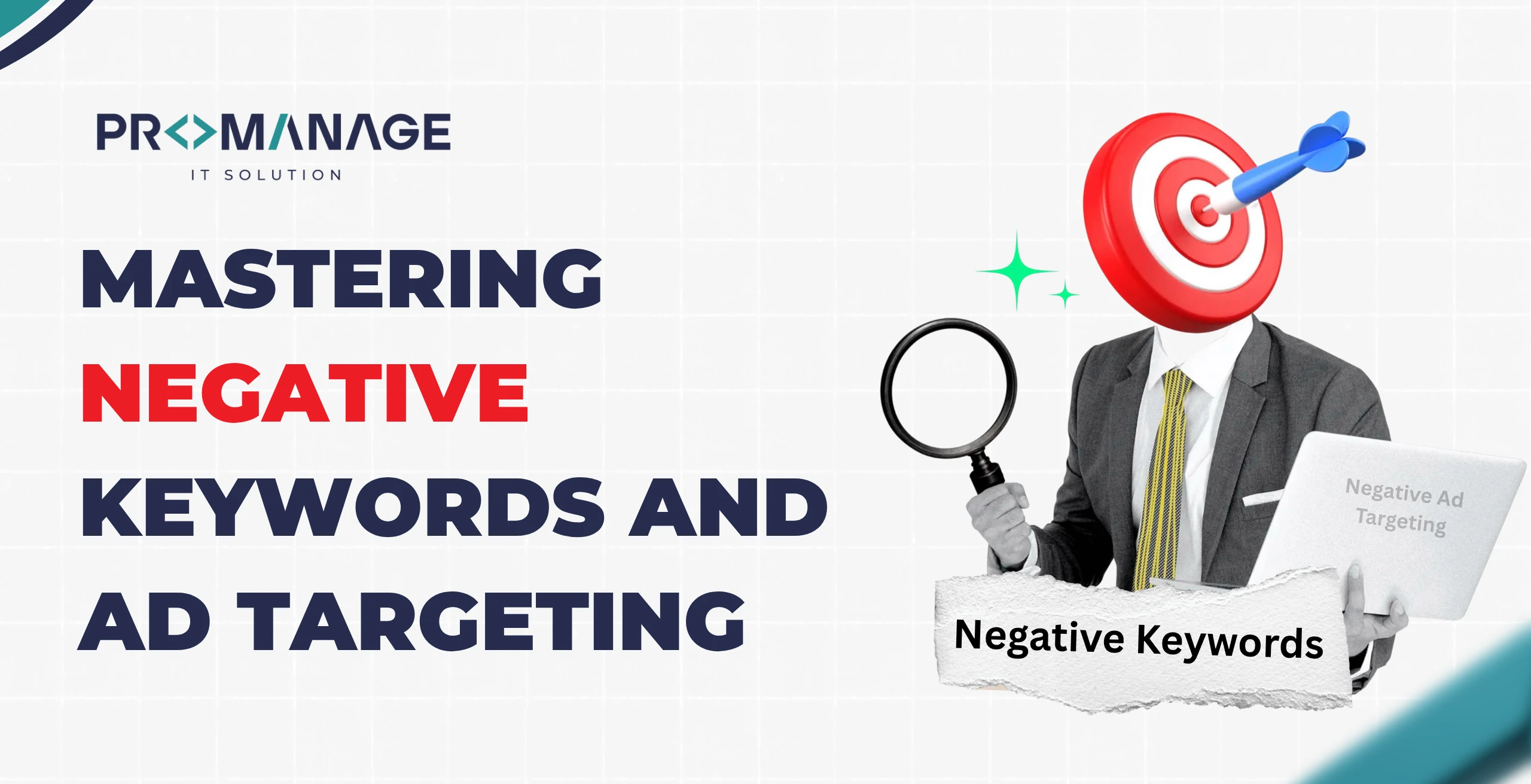Mastering Negative Keywords and Ad Targeting

Negative keywords prevent your ads from appearing to people who are unlikely to buy. That reduces wasted clicks and keeps your budget in check. It helps your ads reach the right audience. Understanding negative keywords helps you control your ads better. In this blog, you will learn what these keywords are and the way they work. You will understand the way to use them well. In addition, you will find why they matter and the different match types. Also, you will see simple yet powerful ways to get the most out of them. This knowledge will help beginners and experienced advertisers, and it will improve the return on investment (ROI) of your business.
What Exactly Are These Keywords?
They act like filters in your advertising. You choose keywords to show your ads to people who search for certain terms. But you use a negative keyword to stop your ads from appearing for unwanted searches.
You might run a campaign for premium watches. You want to avoid showing it to people who look for cheap or free ones. Your main keywords invite the right searches, and the negative ones block the rest. These filters let you shape who sees your ads. It helps you avoid wasting money on irrelevant clicks.
Let’s look at a simple example. Imagine you run an online shoe store and promote “leather shoes.” You want to avoid wasting money on people searching for terms like “fake leather shoes” or “second-hand shoes.” By adding “fake,” “plastic,” or “used” as negative keywords, you stop your ads from showing for those irrelevant searches. In Google Ads, you can add these by going to your campaign, clicking on Keywords, then selecting Negative Keywords. This setup makes sure that your ads reach the right buyers and not those looking for something you don’t offer.
Difference Between Negative and Regular Keywords

Negative keywords work alongside your main keywords, but they do the opposite job. Regular keywords tell platforms when to show your ads. They attract the right searches. Negative words, on the other hand, tell platforms when not to show your ads. They filter out the wrong audience.
Think of it like making a guest list for a party. Your keywords are the people you want to invite. In contrast, your negative keywords are the people you want to avoid inviting. When you use both, your campaign becomes more focused and effective.
Where to Add Negative Keywords in Platforms?
Adding negative keywords is simple.
- In Google Ads, you go to your campaign settings.
- Here, click Keywords.
- Then, find the Negative Keywords tab.
- From there, you can choose to apply them to a specific ad group, the whole campaign, or even your entire account.
Bing Ads offers a similar method. Always review the structure of your campaigns so you know where to place each keyword for the best effect.
They Save You Money and Increase Value
Every paid click costs you money. So, you want only engaged people arriving at your website. Negative words stop ads from showing to users who will never convert. That improves your click‑through rate. It helps your ad rank better because more people who see it click. Over time, the mix of accurate targeting and smart exclusion boosts your campaign performance. You get more valuable traffic. You spend less on irrelevant searches. So, your budget goes further and your return on investment grows.
How Negative Keywords Improve Quality Score?
Using negative keywords helps your ads appear only for the right people. This leads to more clicks from users who care. When your click-through rate goes up, it improves your Quality Score. This is a rating that platforms like Google use to decide your ad’s rank.
A higher quality score means you pay less per click and your ads show in better positions. So, negative keywords not only protect your budget. They also help your ads perform better overall.
Understanding Match Types to Control Exclusions
These keywords come in three main types.
- Broad‑match blocks any search with the keyword, no matter its order or position.
- Phrase‑match blocks when the exact phrase appears in the search.
- Exact‑match blocks only that precise search term.
These levels let you choose how tightly you wish to block unwanted searches. Broad‑match gives the most coverage. But it may exclude some useful searches. Exact‑match gives precise control. But may need many entries. Good use of match types helps you balance coverage with accuracy.
Finding Unwanted Searches in Your Campaign Data
Platforms show you the actual search terms that triggered your ads. Reviewing those terms helps you spot irrelevant queries that still show your ads. You look for words that don’t match your offering and intent. Ask yourself whether someone who used that search would click your ad and take action. If the answer is no, treat it as a negative keyword. Regular review of your search term reports helps you improve performance. You cut waste and focus your budget on clicks that matter.
Deciding Where to Apply These Keywords
You can apply negative words at different levels. You can do it across your whole account, against a specific campaign. You can do it within individual ad groups. If you know that certain words never fit any of your campaigns, exclude them globally.
If a particular campaign targets luxury goods, block words relating to budget options for that campaign only. Within a campaign, you might have ad groups for different product lines. You can tune each ad group by excluding terms that belong to another group. This approach gives you fine control across your whole account.
Using These Keywords in Smart Campaigns
Smart Campaigns make many decisions for you automatically. But they give limited control over negative keywords. That can be tricky when you want to filter out poor traffic.
Some platforms may let you ask for support to add common exclusions for Smart Campaigns. But for full control, it’s better to use Search Campaigns. There, you can manage keyword match types and exclusions freely. If you’re serious about refining who sees your ads, switching to a campaign type with full keyword control is worth it.
Cultivating Your List of These Keywords
You start with obvious exclusions, such as “free”, “cheap”, “jobs”, or “near me” if they don’t apply to your goals. Then you regularly scan your search term report. Pull out anything irrelevant and misleading before it drains your budget. You might also spot new, unwanted terms that emerge from seasonal trends and changing user behaviour. Keeping your list fresh keeps your campaigns efficient. It protects your budget.
List Of Some Useful Tools
To build your negative keyword list faster, try using keyword research tools. Google Keyword Planner and SEMrush show related and trending searches. You can scan them to find terms that don’t match your offer. You can add them as negatives. These tools also help you understand what your target audience isn’t looking for.
Examples of Irrelevant Clicks
Different businesses have different unwanted searches. For example, a luxury hotel may want to block words like “cheap stay” or “hostel”. A company selling paid online courses might block terms like “YouTube tutorial” or “free training”. By thinking about what your audience should not be looking for, you can better protect your budget. You can filter traffic more accurately.
Common Mistakes to Avoid with Negative Keywords
When using negative keywords, small mistakes can cause big problems.
- One mistake is using broad match terms too freely. That might block useful traffic.
- Another is forgetting to include both singular and plural forms. For example, blocking “book” but not “books” may leave gaps.
- Also, many advertisers forget to review and update their keyword lists. Your business changes, and so does search behaviour. Without updates, your list may block the wrong terms or miss new, irrelevant ones. Keep checking and refining for the best results.
Avoiding Harmful Over‑Exclusion
You do need to balance carefully. If your list becomes too large and too strict, you risk excluding people who could convert. Think of negative keywords and target keywords as two sides of a coin. Over‑blocking may protect your budget. But it can also block useful searches. Under‑blocking may waste money. Stay alert for any drops in traffic and conversions that may signal over‑blocking.
Simple Do’s and Don’ts for Using Negative Keywords
| What To Do | What To Avoid |
| Review your search term reports on a regular basis. | Never add negative keywords without reviewing results |
| Use different match types based on campaign needs | Do not rely only on one match type blindly |
| Start with basic filters like “free” or “cheap” | Never assume all budget-related terms are always useless |
Using Events and Seasonal Searches to Refine Your Ads
Search behaviour changes based on trends and seasons. If something dominates the news and you see a related spike in irrelevant searches, quickly block those words. That keeps your ads on track and saves budget. Similarly, seasonal topics may bring unwanted clicks. Adjust your negative keyword list to reflect what people search for during those times. That way, your campaign stays relevant during events and busy periods.
Checking Your Progress and Ad Performance

Once you apply negative words, watch what happens. You should see fewer wasted impressions and better click‑throughs. You might need to tweak your listings based on the way the performance evolves. Ads that slowly improve show that your list works. But if performance drops and your traffic sinks unexpectedly, double‑check your keywords. Make sure you have not blocked terms that drive conversions.
Growing Your Strategy Over Time
The longer your campaigns run, the clearer your ideal audience becomes and the more waste you spot. That lets you refine your positive targeting and negative filters. Successful advertisers build “source of truth” lists that travel from one campaign to the next. They share broad exclusions across the account. They make campaign‑level edits. They use ad group filters for fine-tuning. Over time, they identify which terms always damage performance. They exclude them across everything.
Creating a Master Negative Keyword List
As you run more campaigns, you will start to notice some unwanted terms that come up again and again. These are perfect for a master negative keyword list. It is a reusable list that you apply to new campaigns right from the start.
You can group these terms by industry, product type, or location. For example, terms like “free,” “DIY,” or “training” might always be irrelevant for your paid product. Keeping your list up to date helps you save time. It helps you avoid repeating the same exclusions in every campaign. Over time, a strong master list becomes a reliable tool for running more efficient and targeted ads.
Conclusion
Taking time to manage negative keywords changes your advertising. You remove unwanted clicks. You save budget and reach people who truly care about your offering. You shape who can see your adverts with thoughtful exclusions and careful review. Over time, your campaigns become leaner and effective. The power of these keywords lies in your insight into what does not work. That gives you the space to focus on what does. With smart use, you can boost performance. You can sharpen results and get better value for your advertising investment.
If you want more details on this aspect, then talk to the experts at ProManage IT Solution. You can also connect with our support team for any further queries.













SEO Team Lead
Preeti is a skilled SEO Team Lead passionate about boosting organic traffic and improving search rankings. She leads with data-driven strategies to help businesses grow online effectively.